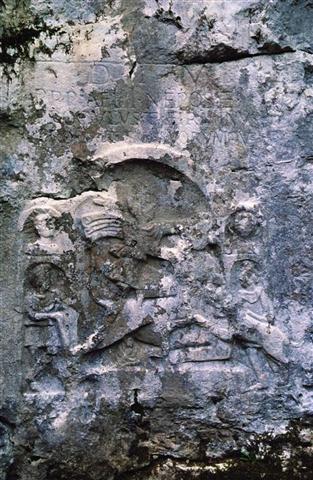
In the heart of Slovenija’s Bela Krajina region, just a short walk from the tiny village of Rožanec, lies a truly remarkable archeological site. Small signs lead curious visitors to the Rožanec Mithraeum, but few tourists – Slovenian or foreign – are aware of the site.
The Rožanec Mithraeum, most likely created in the second century A.D., is a shrine once used by believers of the ancient and mysterious Mithraic faith. The cult had its origins in Persia, but it expanded westwards through ancient contacts between the East and the West, and attained a large following in the Roman Empire, especially among soldiers. The location of the Rožanec Mithraeum is not coincidental; a Roman road once passed near the site.
At the heart of Mithraeum, which lies in a pit surrounded by dense forest, visitors can observe a relief of the god Mithras carved into a rock. He is portrayed slaying an angry bull. The scene, known as “tauroctony,” is a common motif of Mithraic art. According to inscriptions on the rock, the image was created on the orders of three Roman men – possibly brothers – who wanted to ensure the well-being of their family members.
There are other Mithraic sites in Slovenia, but few have yielded as much archeological insight as the one at Rožanec. Archeologists have discovered evidence of sacrificial fires burned in front of the carving. (Some historians, noting the theological similarity between Mithras and Jesus, believe that modern-day Christmas has its roots in these rituals.) Also found in the area were bones, shards of Roman pottery, as well as various coins, which helped scientist to determine for how long the shrine remained in use. Some of the coins suggest that the Rožanec Mithraeum, being so far from the imperial capital, remained in use even after the cult was officially banned in the Roman Empire when Christianity became the sole official faith in the fourth century A.D.
In the centuries after the fall of Roman civilization, various folk tales about the unusual shire emerged among the local population. According to one of the legends, a Golden Calf was buried near the shrine. But it wasn’t until the 1920s that area received attention from the scientific community. In recent years, scientists discovered that pollution was causing the rock to erode at an alarming rate. This led them to create a cast of the relief, which is now on display at the Museum of Bela Krajina in Metlika.
Still, visitors who opt to visit the original at Rožanec are in for a special treat. They can admire a spectacular archeological monument in its original environment, much as it had looked in the waning days of the Roman Empire, when a unique faith briefly challenged Christianity for spiritual dominance in civilized Europe.


































































